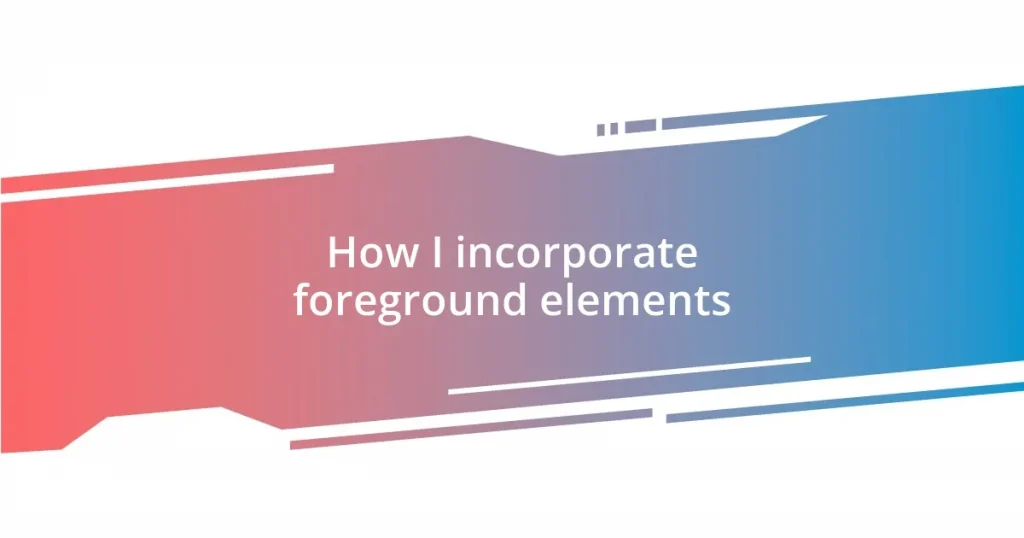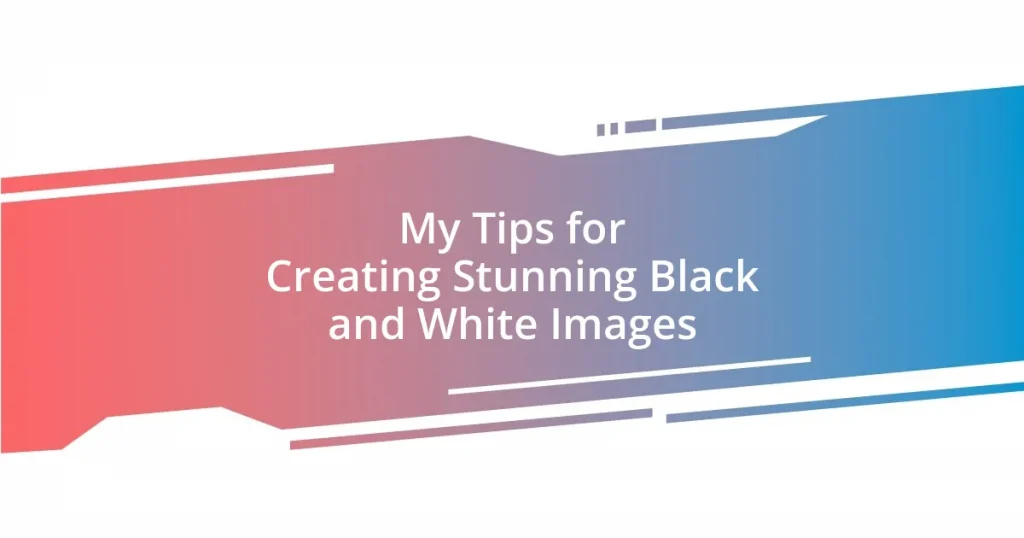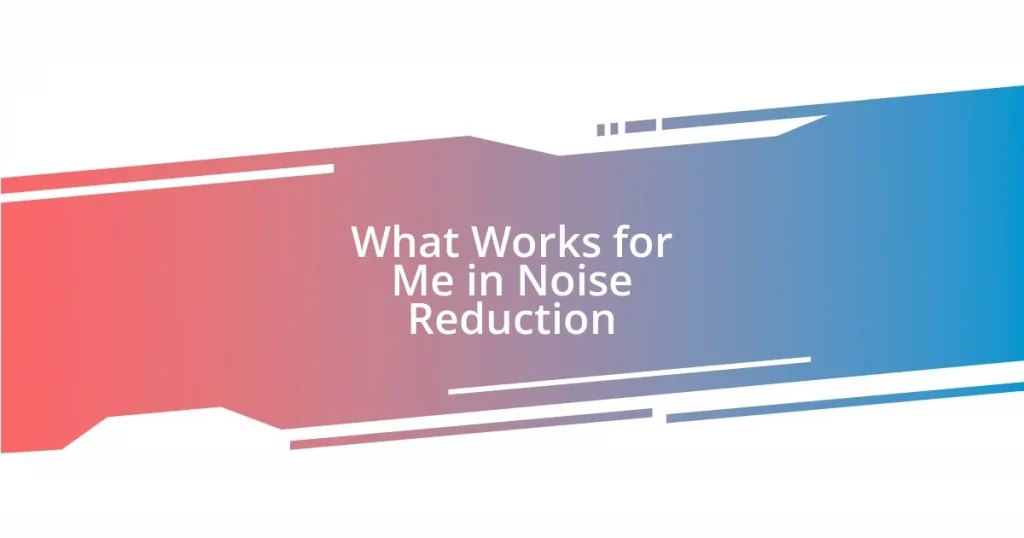Key takeaways:
- Foreground elements enhance visual depth and emotional resonance, making scenes more immersive and engaging.
- Identifying suitable foreground subjects involves considering relevance, color contrast, perspective, emotional resonance, and dynamic shapes.
- Techniques like layering, using leading lines, and contrasting textures can transform ordinary images into captivating experiences.
- Balancing foreground and background is crucial for managing viewer attention and creating a coherent narrative within visual compositions.
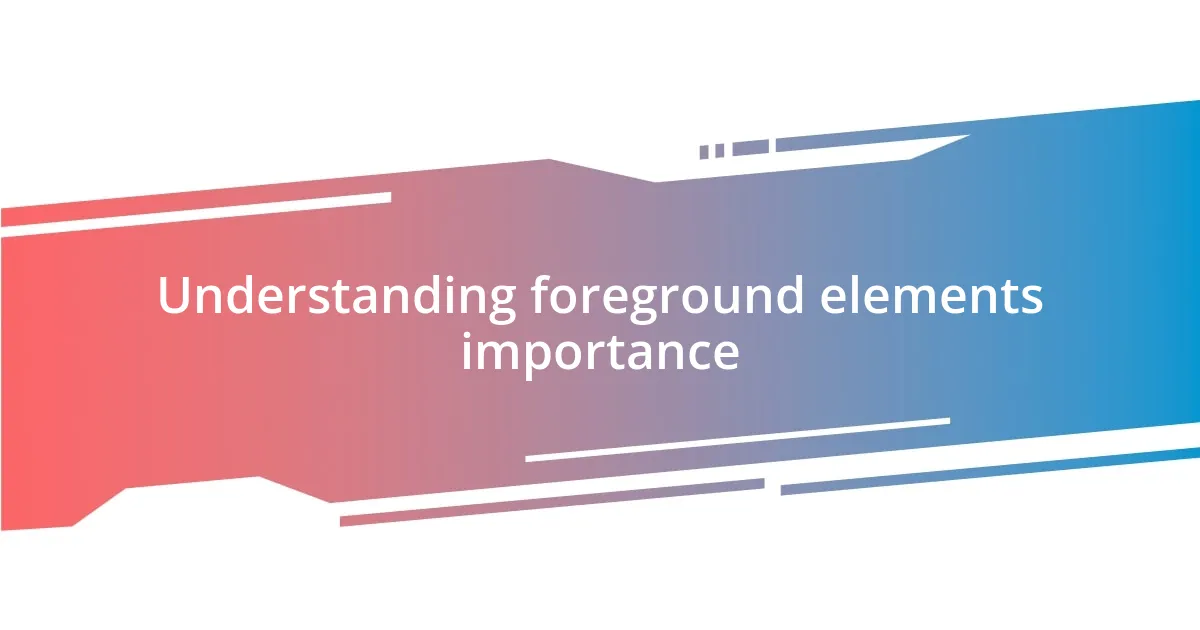
Understanding foreground elements importance
Foreground elements are crucial in any visual composition because they establish depth and draw the viewer’s eye into the scene. I remember the first time I captured a landscape photo and included wildflowers in the foreground. Those little bursts of color not only enriched the image but also made it feel more immersive, creating a connection between the viewer and the environment.
Think about your own experiences with art or photography. Have you ever been captivated by an image where something in the front caught your attention first? That moment is intentional; foreground elements anchor the composition, offering context and enhancing the overall narrative. It’s striking how a simple object can transform a flat scene into something vivid and engaging.
When I work on my projects, I often pause to consider how foreground elements affect the emotions conveyed. For instance, placing an old tree in the foreground of a sunset can evoke nostalgia and warmth. It’s fascinating how these elements can influence not just the aesthetic, but also the feelings that the artwork elicits. What do you think? Have you ever noticed how foreground elements shift your perception of a piece?
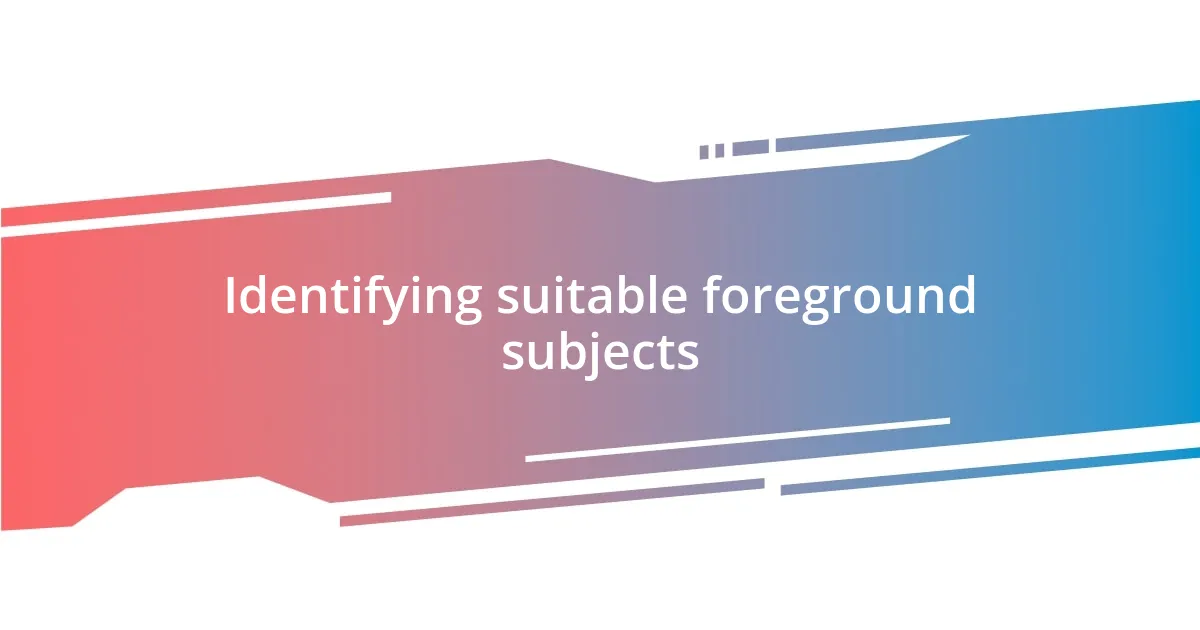
Identifying suitable foreground subjects
Identifying suitable foreground subjects can significantly enhance your composition. I often find myself looking for elements that add not just visual interest but also a narrative to the image. For example, one time I positioned an old bicycle against a weathered fence, and it created an immediate story within the frame. The bicycle hinted at adventures past, sparking curiosity and inviting viewers to imagine who rode it and where they went.
To effectively identify suitable subjects for your foreground, consider the following points:
- Relevance: Choose objects that relate to the overall theme or message of your piece, creating a coherent story.
- Color Contrast: Look for elements that offer vibrant colors or unique textures to draw the viewer’s eye.
- Perspective: Select subjects that contribute to the sense of depth, enhancing the three-dimensional feel of the image.
- Emotional Resonance: Opt for items that evoke memories or feelings, as this connection can make your work more impactful.
- Dynamic Shapes: Incorporate objects with interesting shapes that can guide the viewer’s gaze throughout the composition.
This approach not only enriches the visual experience but also deepens the story you’re telling through your work.
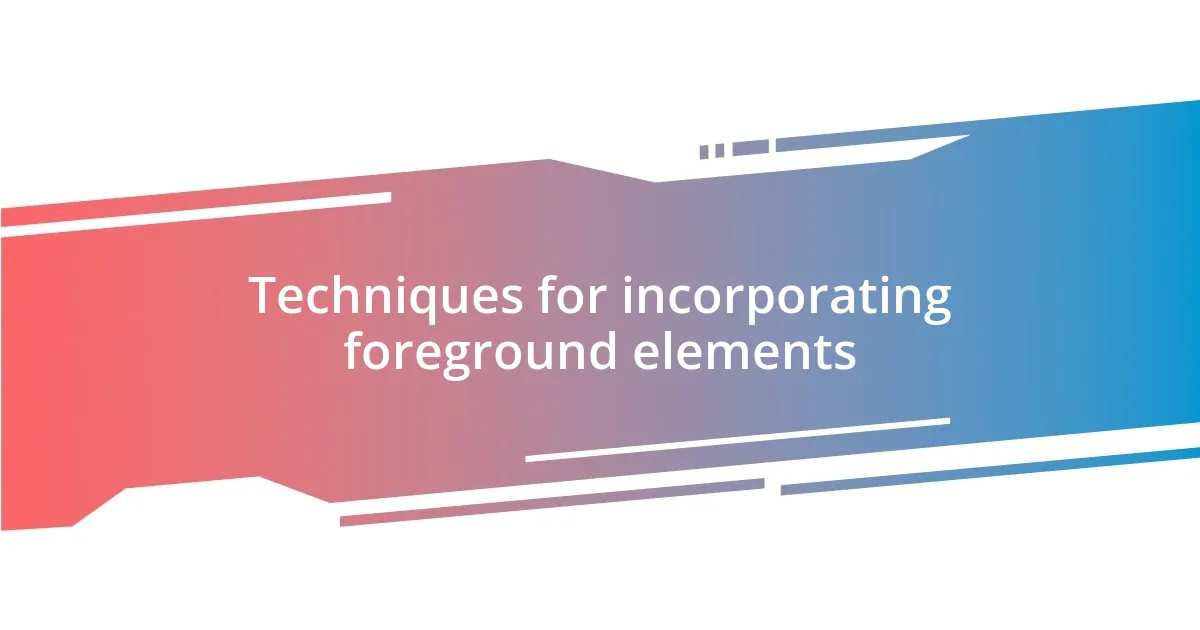
Techniques for incorporating foreground elements
Incorporating foreground elements into a visual composition can transform an ordinary scene into something extraordinary. One technique I often employ is layering different subjects. For example, while photographing a mountain range, I might include a person or an animal in the foreground to create a sense of scale and invite the viewer into the scene. This approach captivates the audience, making them feel like part of the moment rather than just an observer.
Another method that resonates with my personal style is utilizing leading lines. I remember capturing a shot of a pathway lined with trees that seemed to draw the viewer’s eye into the distance. By placing elements like a fence or a winding road in the foreground, I can guide the viewer’s gaze while enhancing the composition’s depth. It’s incredible how such simple shapes can work wonders in directing attention and creating a dynamic scene.
Finally, contrasting textures can be a game-changer. I once took a photograph of a rugged cliff with soft flowers in the foreground. The juxtaposition of rough and delicate not only created visual interest but also evoked a deeper emotional response. This technique illustrates how careful consideration of texture helps to add layers to the story being told, engaging the audience on multiple levels.
| Technique | Description |
|---|---|
| Layering | Combining different subjects to create depth and invite the viewer into the scene. |
| Leading Lines | Using pathways or lines in the foreground to guide the viewer’s eye into the composition. |
| Contrasting Textures | Juxtaposing different textures to evoke emotions and enhance visual interest. |
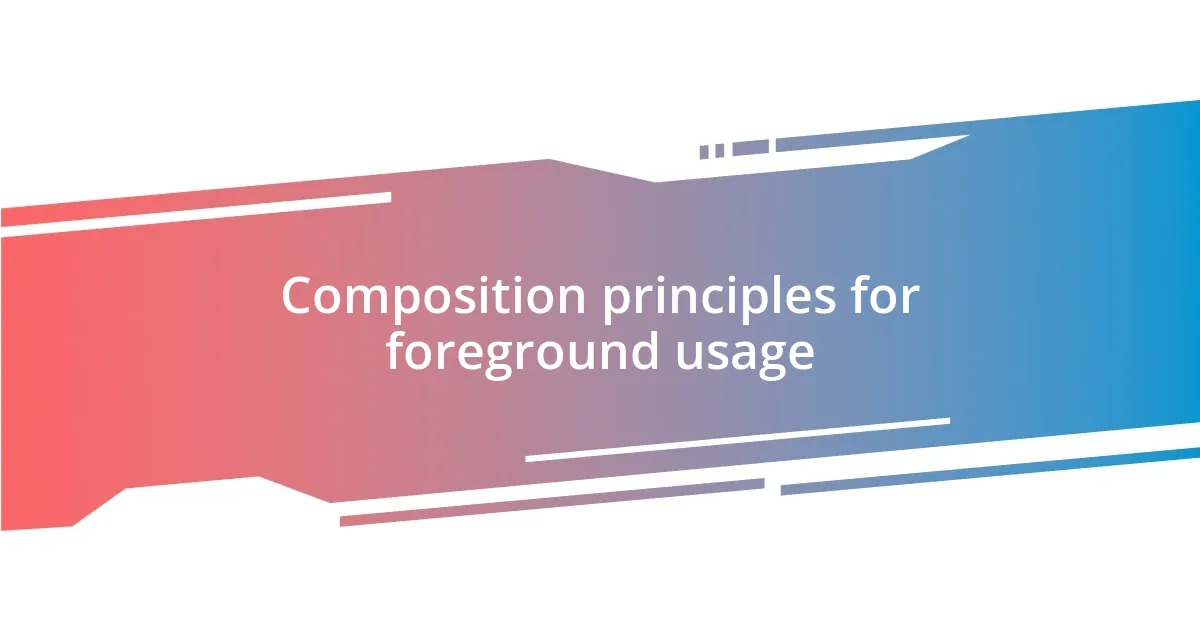
Composition principles for foreground usage
When I think about composition principles for foreground usage, I can’t help but emphasize the importance of balance. Balancing the foreground with the background can create a harmonious image. I recall a moment when I was photographing a bustling market scene, and I realized how too much clutter in the foreground distracted from the vivid action happening behind. By simplifying the foreground to just a vendor’s colorful fruit stand, I allowed the chaos of the market to shine through, enticing the viewer to explore both layers of the scene.
Another principle that often guides my compositions is the idea of framing. Sometimes, the foreground can act like a frame itself. For instance, while shooting a majestic waterfall, I placed some lush bushes in the foreground, which naturally led the viewer’s eye toward the water splashing down. Doesn’t it feel more inviting when an image pulls you in? I felt that framing made the connection more personal, making the waterfall seem even grander and more intimate.
Lastly, I think about the use of negative space in conjunction with foreground elements. It’s surprising how much a simple area of empty space can enhance a composition. I once captured an image of a solitary tree on a hill with an expansive sky behind it. I chose to leave ample room around the tree in the foreground to provide breathing space, allowing the viewer to reflect on the tranquility of the scene. Isn’t it fascinating how the right amount of space can evoke a deeper emotional response? This subtle interplay between elements can truly elevate the impact of your compositions.
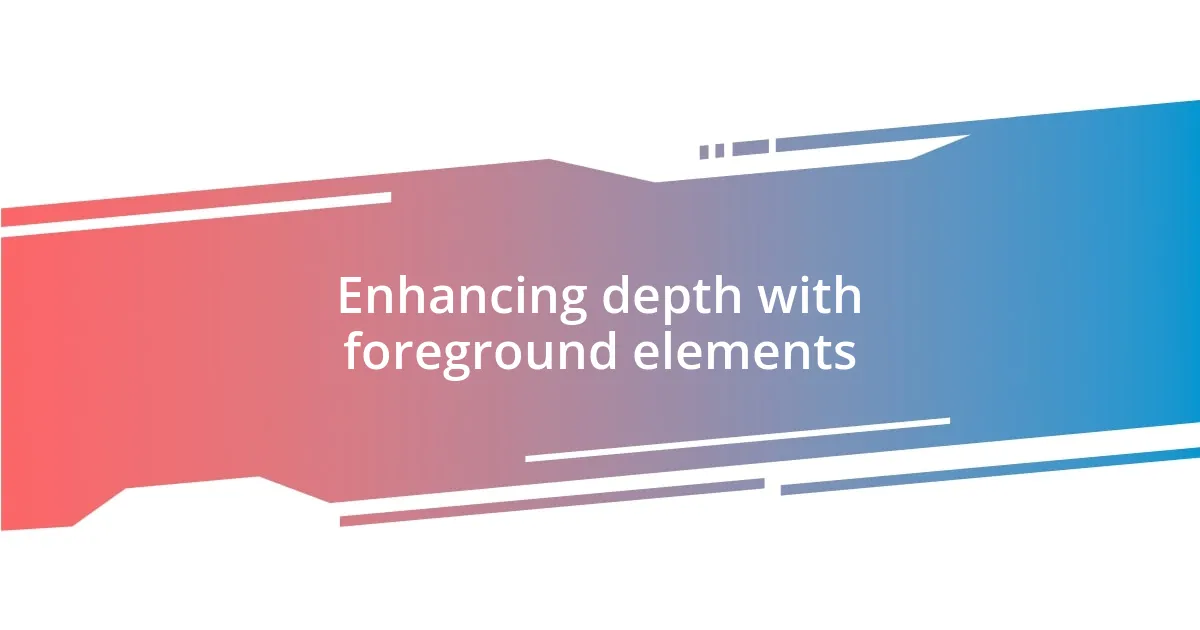
Enhancing depth with foreground elements
Every time I incorporate foreground elements, I notice how they can not only create depth but also add a layer of context to my images. Recently, while walking through a stunning vineyard, I positioned a grapevine in the foreground, framing the rolling hills in the background. The moment I clicked the shutter, it felt as if the vineyard was unfolding itself to the viewer, inviting them into the scene right alongside me. Can you imagine how much richer that experience becomes when you can almost taste the fresh grapes?
Playing with the scale of foreground elements is another technique that resonates deeply with me. I was at a serene lakeside at dawn, and I noticed these smooth stones scattered along the shore. By including them in my frame, I gave a sense of perspective that made the lake appear vast and extraordinary. It’s incredible how these simple stones transformed a tranquil landscape into an expansive world. Doesn’t it make you ponder the vastness of nature in relation to our own tiny experiences?
In my pursuit of artistry, I’ve found that the emotional weight of foreground elements can often reflect a broader narrative. I remember taking a photograph of an elderly couple seated on a park bench, with blooming cherry blossoms framing them. The blossoms not only added vibrancy but also symbolized the fleeting beauty of life’s moments together. Isn’t it amazing how a single element can evoke feelings of love and nostalgia, bridging the gap between viewer and subject? These experiences make incorporating foreground elements feel like a profound dialogue with my audience, enriching their understanding of the scene.
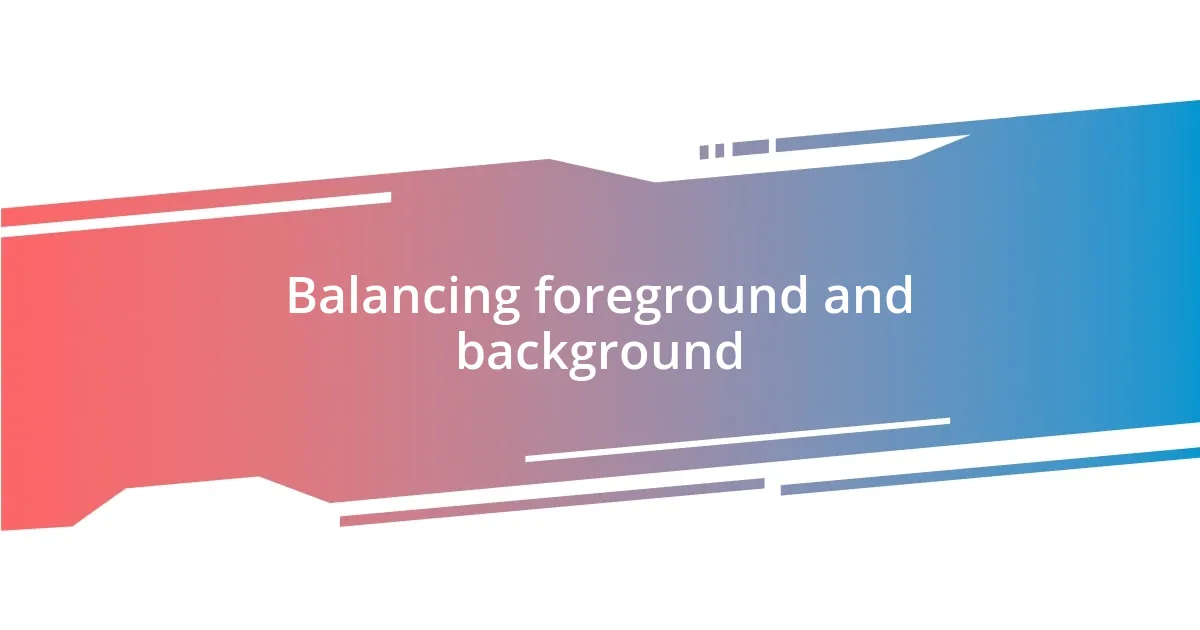
Balancing foreground and background
When it comes to balancing foreground and background, I’ve often found that it’s all about attention management. I remember taking a shot of a busy street, where a vibrant mural filled the background. By thoughtfully placing a couple of artistic bicycles in the foreground, I guided the viewer from the lively market scene to the mural. It’s interesting how this shift in focus can change the story, don’t you think? Each element has its role, and finding that balance creates a narrative depth that compels engagement.
I also think about how foreground elements can lead the viewer’s gaze – guiding them rather than overwhelming them. Once, while hiking through a foggy forest, I spotted a moss-covered log. By incorporating this log in the foreground, it framed the eerily beautiful trees bursting with thick fog behind them. This not only added a sense of mystery but also drew the eye deeper into the forest. It’s as if the log whispered an invitation, enticing you to venture further. Have you ever experienced a moment like that in a photograph, where you feel beckoned into its depths?
Another crucial aspect of this balance is color harmony. In a recent sunset shoot, I kept in mind how powerful color contrasts between the foreground and background can be. I selected a silhouette of wildflowers in the foreground, their dark shapes stark against the fiery oranges and purples of the sunset. This contrast enhanced the drama of the scene, drawing viewers in with the longing to sit among those flowers and watch the day close. Can’t you feel that pull when colors blend harmoniously? It’s a reminder of how well-executed balance can evoke emotion and narrate stories without uttering a single word.
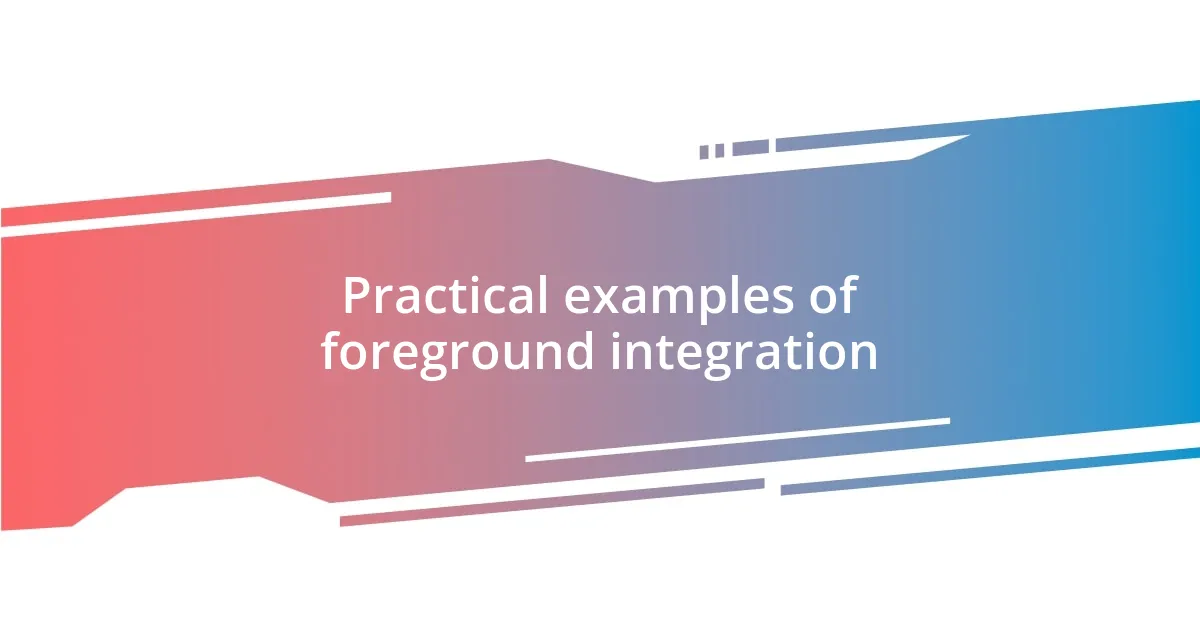
Practical examples of foreground integration
I’ve found that layering foreground elements can dramatically change the mood of a photograph. One morning, I was photographing a serene beach scene when I noticed some seashells scattered in the sand close to me. By incorporating them in my shot, it brought an intimate touch to the vast ocean behind, making the viewer feel as though they were walking right there with me, discovering treasures hidden by the tide. Isn’t it fascinating how such a small detail can invite the viewer to have a personal connection with the scene?
Timing also plays a crucial role in foreground integration. I was once at a bustling farmer’s market when the late afternoon sun cast long shadows. I grabbed a shot where a basket of vibrant tomatoes was balanced against the soft focus of people milling about in the background. This not only highlighted the richness of the tomatoes but also captured the lively energy of the market. Can you feel that vivid contrast? It’s almost like a snapshot of life, where the foreground element acts as a vibrant heartbeat to the bustling background.
Sometimes, I like to play with textures in my foreground elements. During a hike through a rugged canyon, I spotted some rocks that appeared to shimmer in the sunlight. By positioning these stones in the forefront, I not only added depth but also a tactile quality that made the entire scene feel more real. The interplay of light and shadow on those rocks created a dynamic effect against the dramatic cliffs behind them. Have you ever touched a surface in a photograph with your eyes? It’s this kind of sensory engagement that turns a good photograph into a memorable experience.










